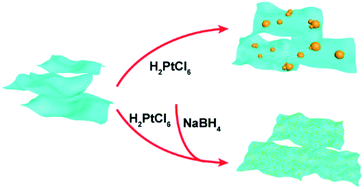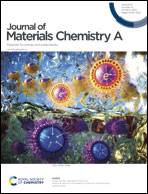Highly dispersed Pt nanoparticles on 2D MoS2 nanosheets for efficient and stable hydrogen evolution reaction†
Abstract
The dispersion of noble metal nanoparticles (NPs) over the surface of two-dimensional (2D) transition metal dichalcogenides (TMDs) creates an efficient electrocatalytic framework which combines the superior catalytic capability of noble metal NPs with the large accessible surface area of 2D TMDs. Here, we report a facile route to fabricate Pt-NP-dispersed MoS2 nanosheets (E-MoS2-Pt-r) whose electrocatalytic hydrogen evolution reaction performance exceeds that of the commercial Pt/C catalyst. The spontaneous reduction of H2PtCl6 by electrochemically exfoliated MoS2 (E-MoS2) can be regulated by the assistant reductant NaBH4. By adding NaBH4, small and highly dispersed Pt NPs are formed on E-MoS2 nanosheets which provide abundant catalytically active sites. The E-MoS2-Pt-r electrode shows an overpotential of 38 mV at a current density of 10 mA cm−2 and the Pt-like catalytic kinetics with a Tafel slope of 29 mV dec−1. It also demonstrates exceptional electrocatalytic stability, which shows no decay for 1000 cycles of cyclic voltammetry tests and maintains a stable current density at a constant overpotential of 50 mV for 10 hours. Furthermore, the mass activity of Pt in E-MoS2-Pt-r is enhanced nearly six times as compared to that of the Pt/C catalyst.



 Please wait while we load your content...
Please wait while we load your content...